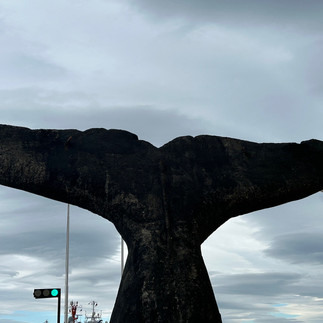Punta Arenas and the Magellan Straight
- danrn4
- Dec 30, 2023
- 3 min read

GA Day 23 (cruise day 7) - we are edging closer to the bottom of the world but, first, a stop in Punta Arenas (Spanish for "sandy point") on the Magellan Strait. This scenic and strategic place was first explored by Ferdinand Magellan, a Portuguese naval officer who was financed by the Spanish crown to seek an alternative trade route to the West Indies.
Punta Arenas is a fairly small port and, as we were beaten here by the Viking Jupiter, had to tender in rather than dock at the quay. At one time the area had copper and a bit of a "gold rush" but now is known more for salmon fisheries, tourism for sea life (whales, dolphins, and penguins), and a stopover for merchant and fishing vessels crossing from one ocean to the other.
Fort Bulnes was one of the attractions in the area located about 60 km southwest of the current Puerto Arenas and was originally built to defend colonization of this area of Chile and the Magellan Strait. However, the location was a poor choice for a settlement being open to the elements and having very little arable lands around it - it lasted about five years before there was a mutiny and the fort was burned to the ground. We had a really entertaining and knowledgeable tour guide who shared the history of the area back to about 8,000 BCE when the original Indigenous peoples inhabited the islands as either fishing communities or nomadic hunters. These peoples were wiped out by a sudden ice age caused either by a volcanic eruption or meteor...no one really knows for sure what happened but this had occurred well before colonization.

Once again the vista in all directions was spectacular with the variations of lighting in the clouds and on the water being a visual feast. The picture to the right shows the original spit of land where Puerto Arenas was originally built before it moved east. Aside from the wee sheltered harbour the whole area was exposed to harsh winds that funneled down the strait - I imagine winter would be a treat here.

The vegetation in the area is quite sparse - some of it reminded me of the alpine meadows one sees in the Singing Pass on Whistler or, I imagine, is similar to that of the Scottish highlands. There were pastures for cattle, sheep, and llamas but, as the guide mentioned, it would take 2 acres of land to feed one sheep or llama and 10 acres to feed one cow. The one native species of tree, a hard oak, would take something like 10 years to grow 1" in girth due to the nature of the soil but with badly controlled burning much of the forests have been reduced to nothing. Still, hearty plants take root to produce berries and an appreciable contrast of colour to the surrounding rock faces and snowcapped mountains.
On the ride along the Magellan Strait back to Puerto Arenas we were fortunate to see pods of dolphins breaching the waters around strands of kelp where the fish hang out. It was quite amazing to see them work in packs to stir up the waters in an attempt to flush out their meal - it seemed to be more play than work. Also along the shore were many ship wrecks left abandoned to rust in the elements - like the uncontrolled burning, another mark on the environment by man.















Comments